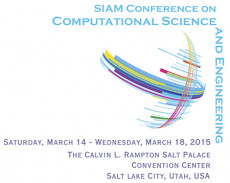Computing Sciences Staff Presenting at SIAM CSE15 Conference
March 11, 2015
Computing Sciences staff will be presenting some three dozen research talks and posters at the 2015 SIAM Conference on Computational Science and Engineering (CSE15) being held March 14-18 in Salt Lake City. Here’s a list of NERSC and CRD contributions:
Minisymposia Talks
- Jim Demmel of CRD and UC Berkeley is a co-author of “Avoiding Communication in Distributed-Memory Tridiagonalization” and of “Efficient Deflated-Based Preconditioning for the Communication-Avoiding Conjugate Gradient Method”
- Daniel Martin, Peter O. Schwartz and Esmond G. Ng of CRD are co-authors of “Improving Grounding Line Discretization using an Embedded-Boundary Approach in BISICLES;” Daniel Martin is presenting.
- Juliane Mueller of CRD is presenting “Miso: Mixed-Integer Surrogate Optimization for Computationally Expensive Black-Box Problems.”
- Meiyue Shao of CRD is presenting “Multi-Level LOBPCG Method in MFDn.”
- Osni A. Marques of CRD is presenting “Revisiting SVD(A) through EIG(T) for Sca/LAPACK.”
- Elijah Goodfriend of CRD is a co-author and presenter of “Using Explicit Filtering and Reconstruction to Improve Large-Eddy Simulation of the Atmosphere on Adaptive Grids.”
- Hans Johansen of CRD is a co-author of “Overview: Software Productivity Challenges for Extreme Scale Science.”
- Per-Olof Persson of CRD and UC Berkeley is presenting “High-Order Methods for Turbulent Flow Simulations on Deforming Domains.”
- Brain Van Straalen of CRD is presenting “Runtimes and Autotuning and Hybrid, Oh My! Chombo Navigates the Waters of Exascale.”
- Robert Saye of CRD is presenting “High-Order Quadrature on Implicitly Defined Domains with Application to a High-Order Embedded Boundary Discontinuous Galerkin Method for Evolving Interface Problems.”
- Xiaoye Sherry Li of CRD is a co-author of “A Distributed CPU-GPU Sparse Direct Solver.”
- Mathias Jacquelin and Esmond G. Ng of CRD are co-authors of “Next Generation Sparse Symmetric Factorization;” Jacquelin is presenting.
- Dharshi Devendran and Hans Johansen of CRD are co-authors of “A Higher-Order Cut Cell Finite Volume Method for Advection-Diffusion;” Devendran is presenting.
- Anshu Dubey and Brian Van Straalen of CRD are co-authors of “Hierarchical Resilience for Structured AMR;” Dubey is presenting.
- Mark Adamsof CRD is presenting “Application of Algebraic Multigrid (PETSc) for Block Structured Adaptive Mesh Refinement Applications (Chombo)” and “Segmental Refinement: A Multigrid Technique for Data Locality” and is a co-author of “Gyrokinetic Poisson Equation Solvers with Explicit Flux Surface Averaging in XGC1 with PETSc.”
- Brian Austin of NERSC and Alex Druinsky, Xiaoye Sherry Li, Osni A. Marques and Eric Roman of CRD are co-authors of “Incorporating Error Detection and Recovery into Hierarchically Semi-Separable Matrix Operations;” Druinsky is presenting
- Andrew Myers, Brian Van Straalen and Phillip Colella of CRD are co-authors of “Controlling Numerical Error in Particle-In-Cell Simulations of Collisionless Dark Matter.”
- Ann S. Almgren of CRD is presenting “Block-Structured AMR: Applications Using BoxLib.”
- Alex Druinsky, Brian Austin, Xiaoye Sherry Li, Osni A. Marques, Eric Roman and Samuel Williams of CRD are co-authors of “Comparative Performance Analysis of an Algebraic Multigrid Solver on Leading Multicore Architectures.”
- Bert de Jong, Hongzhang Shan and Leonid Oliker of CRD are co-authors of “Using Next-generation Architectures to Model Large and Complex Molecular Environments.”
- Jack Deslippe of NERSC is presenting “Massively Parallel GW Calculations for Current and Next-generation HPC.”
- Michael Minion of CRD is presenting of “Developing a Custom Time Integrator for the Nonlinear Schroedinger Equation for an Application in Paraxial Laser Propagation.”
- Chao Yang and Eugene Vecharynski of CRD are co-authors of “A Projected Preconditioned Conjugate Gradient Algorithm for Eigenvalue Calculation.”
- John B. Bell of CRD is presenting “Fluctuating Hydrodynamics of Reactive Multispecies Mixtures.”
- Anuj Chaudhri and John B. Bell of CRD are co-authors of “Modeling Multi-Phase Flow Using Fluctuating Hydrodynamics.”
- Pieter Ghysels of CRD is presenting "Implementation of a Fast Multifrontal Solver Using Randomized HSS Compression."
- Francois-Henry Rouet of CRD is presenting "Using Random Butterfly Transformations to Avoid Pivoting in Sparse Direct Methods."
Contributed Presentations
- Max Duarte and Matthew Emmett of CRD are co-authors of “High Order Schemes Based on Operator Splitting and Deferred Corrections for Stiff Time Dependent PDEs.”
- Max Duarte, Ann S. Almgren and John B. Bell of CRD are co-authors of “A Low Mach Number Model for Moist Atmospheric Flows.”
Posters
- Andrew Canning of CRD is presenting “Hybrid OpenMP/MPI CG Iterative Eigensolver for First-Principles Plane Wave Materials Science Codes.”
- Xiaoye Sherry Liof CRD is co-author of “Sparse Direct Solvers and Preconditioners on Manycore Systems.”
- Anshu Dubey, Phillip Colella, Mark Adams, Ann S. Almgren, Dan Graves, Terry J. Ligocki, and Brian Van Straalen of CRD are co-authors of “FASTMath Structured Mesh and Particle Technologies.”
- Kesheng John Wu and Alex Sim of CRD are co-authors of “Towards Real-Time Blob-Filaments Detection in Fusion Plasma.”
About Berkeley Lab
Founded in 1931 on the belief that the biggest scientific challenges are best addressed by teams, Lawrence Berkeley National Laboratory and its scientists have been recognized with 16 Nobel Prizes. Today, Berkeley Lab researchers develop sustainable energy and environmental solutions, create useful new materials, advance the frontiers of computing, and probe the mysteries of life, matter, and the universe. Scientists from around the world rely on the Lab’s facilities for their own discovery science. Berkeley Lab is a multiprogram national laboratory, managed by the University of California for the U.S. Department of Energy’s Office of Science.
DOE’s Office of Science is the single largest supporter of basic research in the physical sciences in the United States, and is working to address some of the most pressing challenges of our time. For more information, please visit energy.gov/science.










